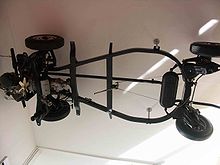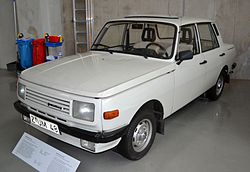War castle 353
| Wartburg | |
|---|---|
|
Wartburg 353 S sedan (1986)
|
|
| War castle 353 | |
| Sales designation: | War castle 353 |
| Production period: | 1966-1989 |
| Class : | Lower middle class |
| Body versions : | Limousine , station wagon , Kübelwagen , pick-up |
| Engines: |
Otto engines : 1.0 liter (33–37 kW) |
| Length: | 4220-4380 mm |
| Width: | 1640 mm |
| Height: | 1495 mm |
| Wheelbase : | 2450 mm |
| Empty weight : | 920-960 kg |
| Previous model | War castle 312 |
| successor | Wartburg 1.3 |
The Wartburg 353 is a passenger car from VEB Automobilwerk Eisenach , which was manufactured from 1966 to 1988.
history
The Wartburg 353, introduced in 1966, followed its predecessors in its basic concept with two-stroke engine , front-wheel drive , box-profile frame, but received the more modern maintenance-free chassis introduced with the transition model Wartburg 312 with 13 ″ wheels, independent suspension and coil springs all around, and a new one that was entirely in line with international standards at the time Body with a trunk of over 500 liters, which, like that of the Wartburg 311 , was drawn by the Eisenach designer Hans Fleischer, supported by the designers Clauss Dietel and Lutz Rudolph .
The basic design of the 353 was based on the study of a full rear -Pkw of Dietel from 1962, from the butcher, the design of the 353 sedan derived. Dietel also contributed to the color design of the interior and the design of some interior components. Whether Clauss Dietel or Hans Fleischer played a decisive role in the design of the 353 is a matter of dispute among experts and contemporary witnesses. As a right-hand drive version, the vehicle was marketed in Great Britain under the name Wartburg Knight (in German: " Wartburg Knight") until it was no longer allowed to be imported in 1974 due to the outdated two-stroke engine.
Model development

ceiling installation in the museum of the automobile world in Eisenach
The transition model Wartburg 312 with the body of the Wartburg 311 and the frame of the later Wartburg 353 was introduced on September 1, 1965 from the chassis number 65.533. From June 1, 1966, vehicles from chassis number 01.30 001 received the new body, combined with a change in the type designation from "1000" to "353". Since July 1, 1966, all vehicles with chassis number 02.14 001 or higher have had a new gearbox.
The introduction of the body works Halle and Dresden crafted combination variant Wartburg Tourist took place in 1968. tailgate and rear fenders were made of glass fiber reinforced plastic made. Initially, the Tourist was manufactured with a closed C-pillar; in 1970, forced ventilation with air outlets in the C-pillar was introduced.
Starting with chassis number 04.10 474, the new engine of the 353-1 type with 36.8 kW was introduced on May 6, 1969 . Since March 3, 1975 / from chassis number 10.06 948, the vehicle has been produced as the Wartburg 353 W ( W = further development) with front disc brakes and many detail changes. The body remained unchanged.
From the chassis number 17.20 932 onwards, the vehicles produced since June 14, 1982 had a Jikov 32 SEDR register carburetor with intake mixture preheating (conversion of older models is not recommended), new rear brake drums and H4 headlights .
From January 2, 1984 on, the Wartburg 353 S ( S = special request) was produced from chassis number 19.00 401 onwards instead of the previous “de luxe” version . The special design, 353 WR has been dispensed, the W in the label in contrast to the rally car, was characterized by matt black PVC door window frame, fittings panel with artificial leather in wood grain, trunk covers, fog lights ( fog lights and -schlusslicht ) Zweiklangfanfare , stick shift / column gear, heated rear window and a Stitchbonding - Cordbezugsstoff . In addition, the previously chrome-plated body parts of all models were coated with black plastic powder.
From chassis number 20.24 100 onwards, the radiator installed behind the engine on all predecessors (including the DKW F9 ) was moved to the front in vehicles produced since June 30, 1985 . The body was therefore given a new front center section without a separate “grill” with modified headlights.
(Even the successors of the DKW F9 built in West Germany, which can be called sister models of the Wartburg, such as the DKW F12 , F102 and Auto Union 1000 always kept the radiator behind the engine.)
The production of the sedan ended with the introduction of the new Wartburg 1.3 model in autumn 1988. The Tourist station wagon version was replaced a few months later, so that in 1989, 1,191 vehicles with two-stroke engines were still produced.
Model range
- Limousine, four-door
- Station wagon, four-door ("Tourist")
- Pick-up, two-door ("Trans")
- Prototypes / special vehicles
- Wartburg 355
- Wartburg with gas turbine drive
- Wartburg Rallye Trans (number of items: 3 (2 × original / 1 × replica), see link)
- Wartburg 353 Rallye Duo, prototype with two engines (quantity: 1, see link)
- Wartburg 353 WR, rally car according to the regulations of group B
- Wartburg 353 W460, rally vehicle
- RGW-Auto 610 M
- Wartburg 360 (similar to the Audi 80 / Audi 100)
- Wartburg 400 (Kübelwartburg for the NVA )
- Wartburg 760 ("pot-bellied pig")
- Special models
- MED emergency vehicle of the DRK of the GDR in the area of rapid medical aid (SMH), urgent medical aid (DMH) and the urgent home visit service (DHD) with a total of around 100 vehicles, four of which are in service with the National People's Army (NVA)
- Melkus RS 1000
production
In addition to the main AWE site in Eisenach, four other companies were included in the production of the Wartburg 353:
- VEB Karosseriewerke Halle (KWH, formerly Ludwig Kathe & Sohn ) - Tourist
- VEB Karosseriewerk Dresden / Radeberg (KWD, formerly Glasses ) - Tourist body
- VEB Automobilwerke Ludwigsfelde - Trans
- VEB Waggonbau Gotha - chassis for the Wartburg 353 W and 1.3
The frames were delivered to the individual plants without a chassis number and completed there for the specific vehicle.
For the production of the Tourist in Halle and Dresden, parts (mechanics, frame and body parts that resembled those of the sedan) were supplied, and the cars were then finally assembled with the station wagon body. Then the vehicles (until 1990) were returned to Eisenach by train and subjected to a final inspection there.
Production figures (1966–1989)
- 1966–1975 Wartburg 353, 356,330 pieces
- 1975–1989 Wartburg 353 W, 868,860 pieces
Numbering scheme
- 1986 to April 1988
- SNE 353 00x G2y zzzzz
- x: 0 = limousine, 4 = trans, 9 = tourist
- y: 1 = 1986, 2 = 1987, 3 = 1988
- z: serial number, with the first digit: 0–6 = limousine, 7 = trans, 8 + 9 = tourist
- from April 1988
- SNE 353 x0y zzz aaaaa
- x: 0 = 2-stroke, 2 = 4-stroke
- y: 0 = Limo, 4 = Trans, 9 = Tourist
- zzz: J8 = 1988, K9 = 1989, L0 = 1990, M0 = 1991
- aaaaa: serial number
Technical data: Wartburg 353
- L / W / H: sedan: 4,220 / 1,640 / 1,495 mm; Tourist: 4,380 / 1,640 / 1,495 mm; Wheel base: 2450 mm
- Engine: two-stroke three-cylinder gasoline engine , liquid-cooled
- Displacement: 992 cm³
- Power: 33 kW / 45 PS (Type 353) / 37 kW / 50 PS (Type 353.1)
- Torque: 100 (until 1986) / 106 Nm at 3000 rpm
- Fuel: two-stroke mixture 1:50, min 88 RON
- Carburettor: Downdraft carburetor BVF-40, from 1982 register carburetor Jikov 32 SEDR
- Transmission: four-speed gear transmission / one reverse gear, fully synchronized
- Freewheel in all gears, manually lockable
- Clutch: Single-plate dry clutch with torsion spring, type: T 10-12K
- Chassis: independent suspension , driven at the front, rims 13 ", tires 165-SR 13, 175/70 R13 or 185-SR 13
- Turning circle: 10.2 m
- Brakes: lockable handbrake , front duplex and simplex drum brakes at the rear (from 1975 front disc brakes)
- Accumulator: 12 V / 38 Ah (from 1981)
- Ignition system: interrupter , one ignition coil per cylinder; electronic ignition can be retrofitted
- Electrical system: DC alternator 12 V / 220 W, from 1975 three-phase alternator 12 V / 588 W.
- Main lighting: from 1978 H4 halogen headlights 60/55 W
- Trunk: 525 l (sedan); L / W / H 1940/1300/860 mm (Tourist)
- Total empty weight / payload / total load: sedan: 920 kg / 400 kg / 1,320 kg; Tourist: 970 kg / 440 kg / 1410 kg
Technical data: Wartburg 353 WR
- Three-cylinder two-stroke engine with 110 hp at 5500 / min and a torque of 142 Nm at 4200 / min, displacement 1147 cm³, three BVF flat-flow motorcycle racing carburetors, three modified Trabant air filters, performance-optimized exhaust system depending on the route, top speed 172 km / h, Mixture 1:40 from a modified 62 liter tank
- Five-speed gearbox with lockable freewheel
- reinforced, closed box-profile frame, coordinated coil springs with gas pressure shock absorbers, internally ventilated disc brakes at the front, drum brakes at the rear, 6J13 cast magnesium rims with 185/60 R13 tires
- Length 4220 mm, width 1642 mm, height 1465 mm, empty weight 815 kg
- Weight-reduced body parts, GFP fenders front and rear, GFP bumpers, GFP bucket seats
- Safety roll cage, detachable auxiliary lights, tachometer, sports seat belts
Technical information
Brake force regulator
The station wagons / camping and later Tourist / Trans had a stronger rear suspension than the sedans. The load-dependent pressure intensifier (LAD) for the rear wheel brakes was introduced in 1975 with the modernized chassis of the 353W. They had a different characteristic depending on the structure (limousine, tourist, trans). In terms of design, however, they were similar to those of the sedan and are therefore partially interchangeable.
LAD types
- Limousine: 17 kp ≡ 16.7 kg, color coding: blue
- Tourist: 31 kp ≡ 30.4 kg, color coding: yellow
- Trans: 15 kp ≡ 14.7 kg, color coding: green
Web links
Individual evidence
- ↑ a b Motor Vehicle Technology, Issue 7/66: The new Wartburg 1000 , detailed technical presentation of the W353 , accessed July 15, 2012
- ↑ Wolfgang Roediger in Der Deutsche Straßenverkehr 7/1966: DER NEUE WARTBURG 1000 , presentation of the W353 , accessed July 15, 2012
- ↑ Excellent! Federal Design Prize for Karl Clauss Dietel ( memento from November 30, 2014 in the web archive archive.today ), mdr.de, September 30, 2014
- ↑ Heiko Kleinschmidt / Horst Ihling: Designer Hans Fleischer shaped the body of the Wartburg , in: Thüringer Allgemeine , September 20, 2014.
- ^ Wartburg Knight , classicandsportscar.com
- ↑ Wartburg 353 Knight , uniquecarsandparts.com.au
- ↑ This is how GDR cars should achieve world-class. In: welt.de. Die Welt , November 7, 2011, accessed March 1, 2016 .
- ^ Peter Kirchberg: Plastics, sheet metal and planned economy . Nicolai-Verlag, Berlin 2005, ISBN 3-89479-259-0 .
- ↑ Technical data Wartburg 353 W










